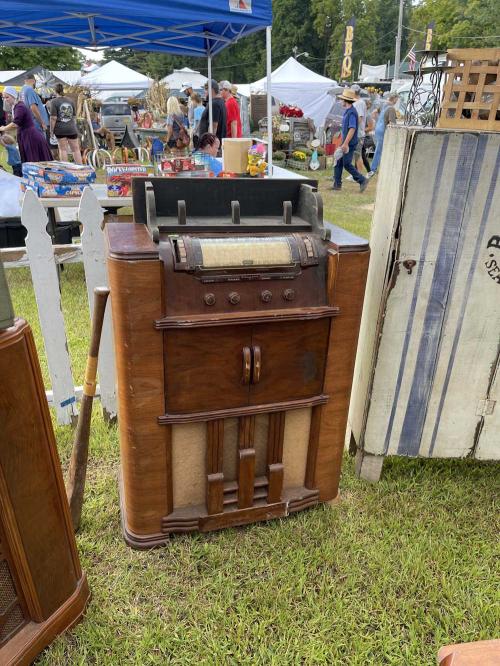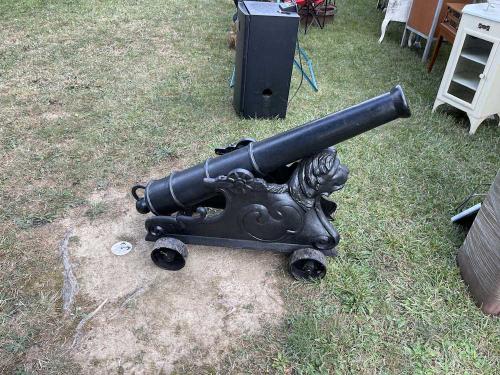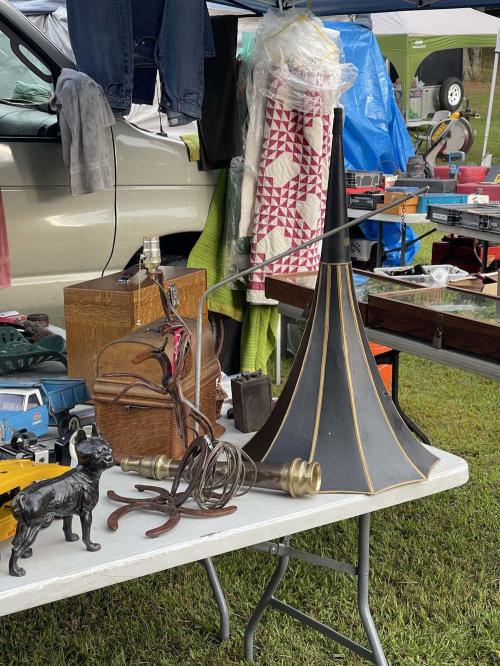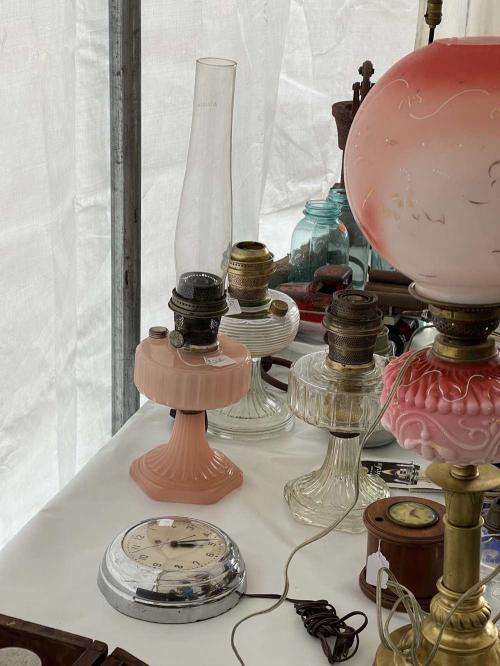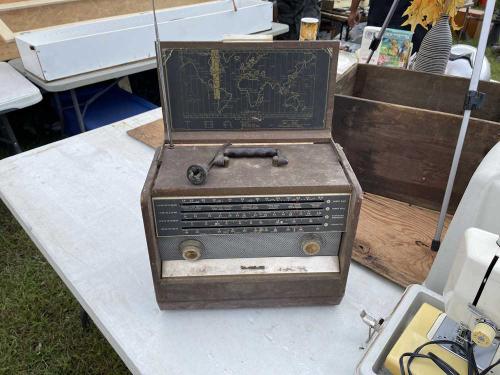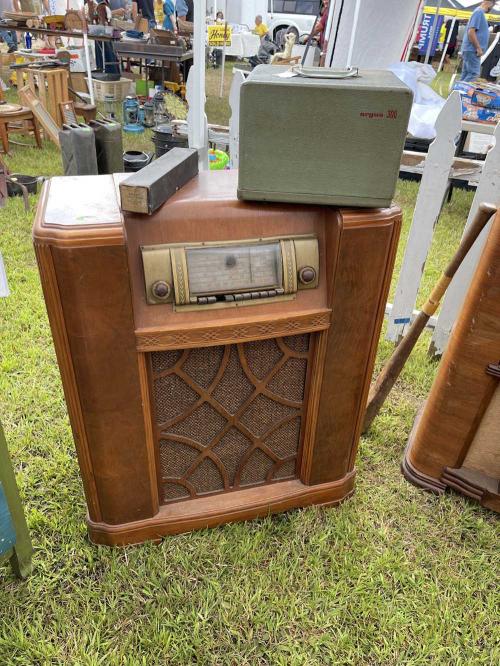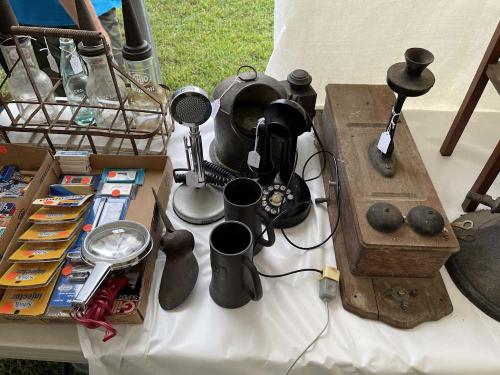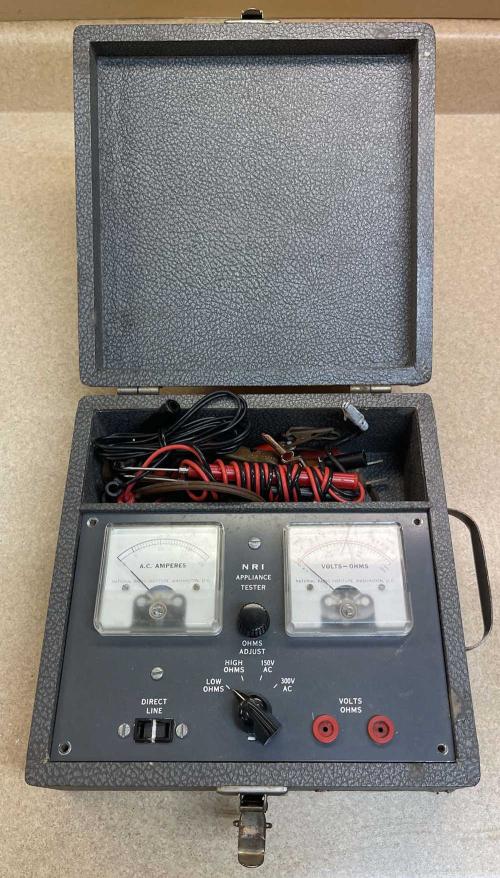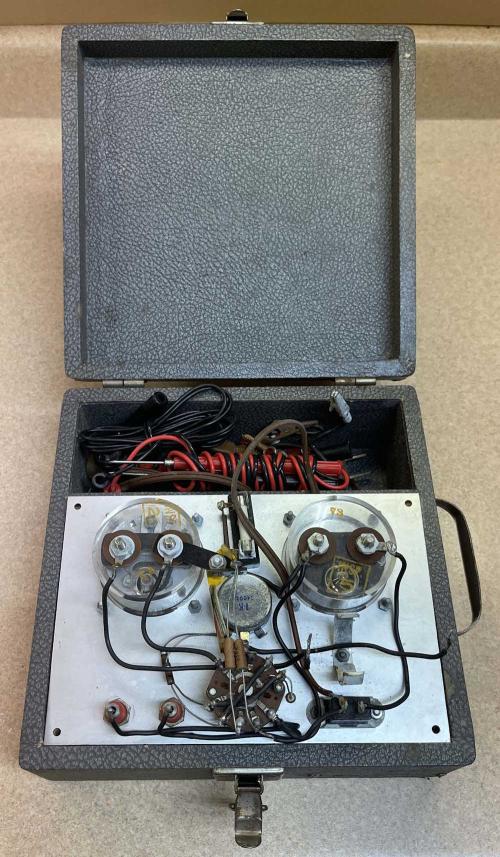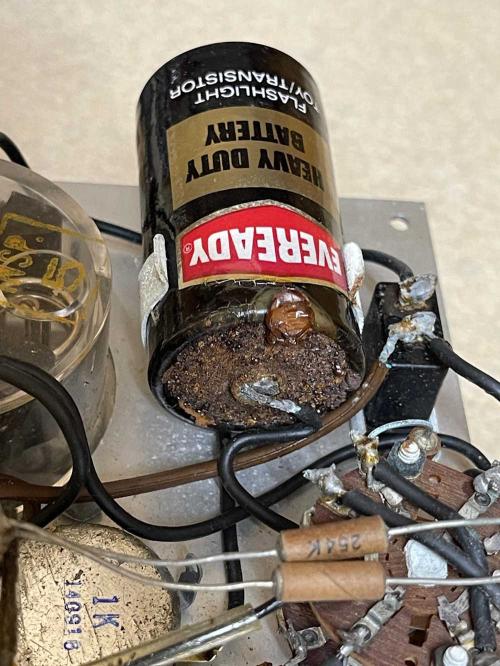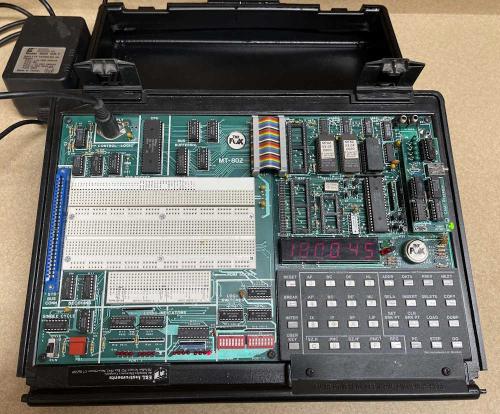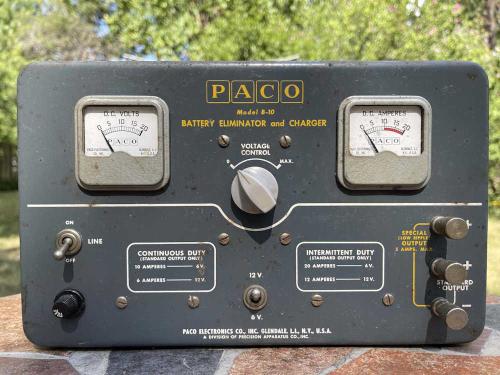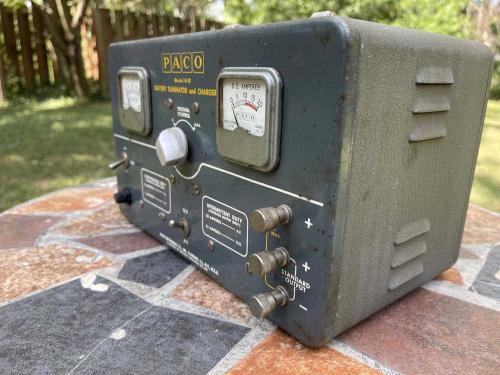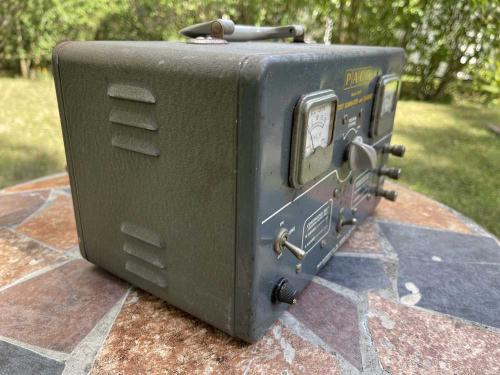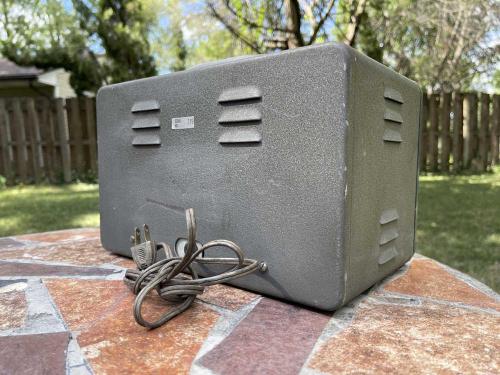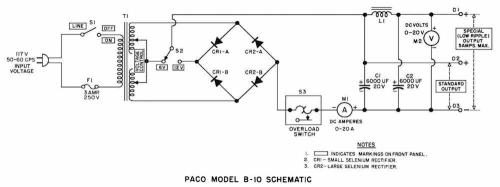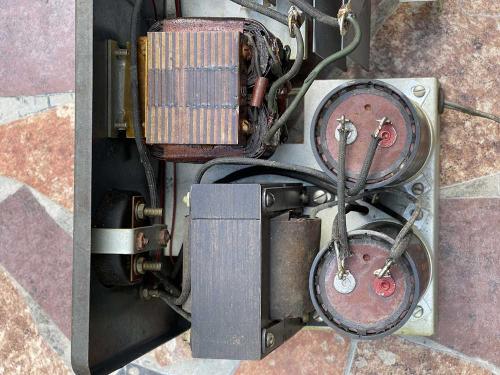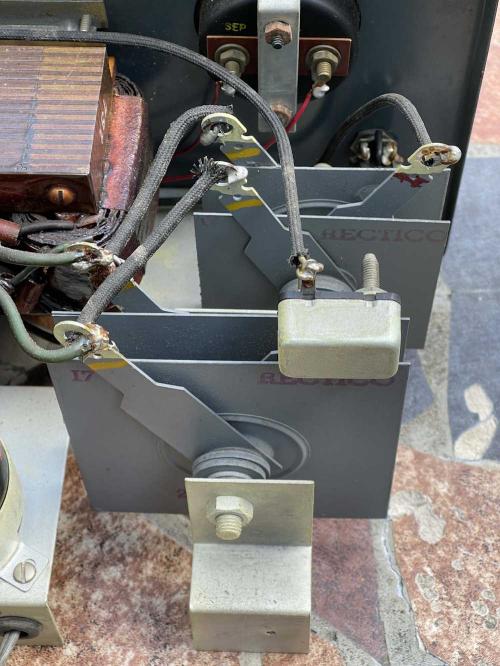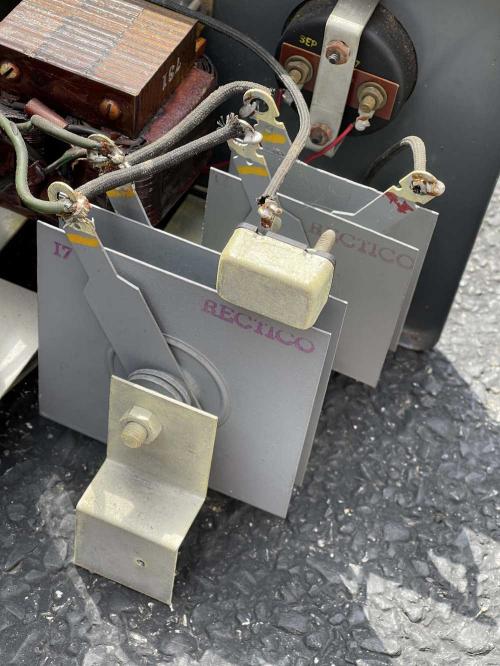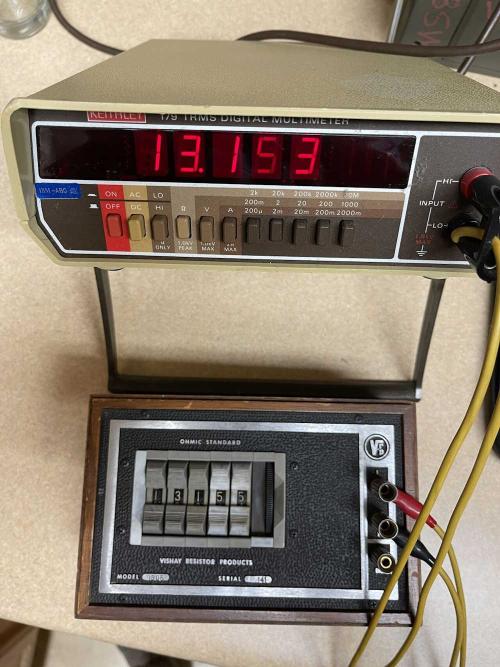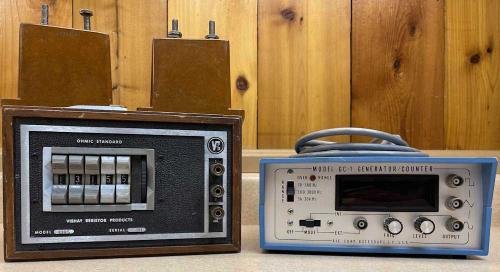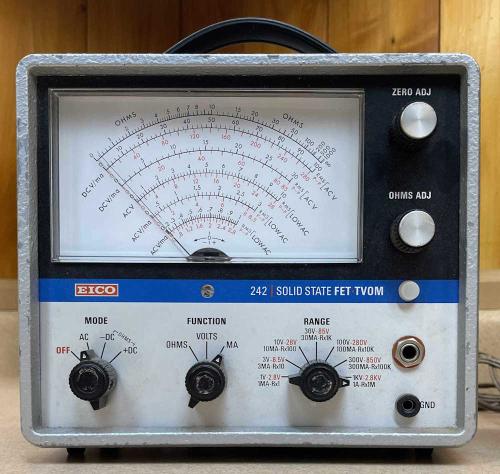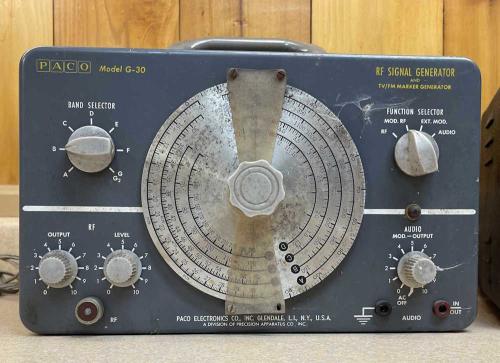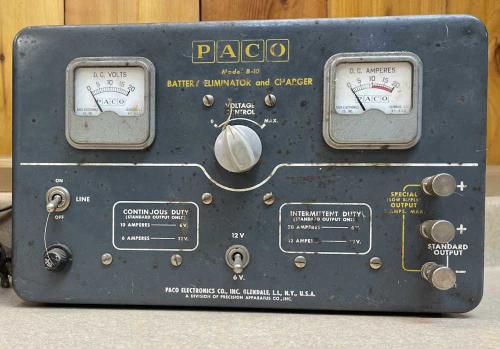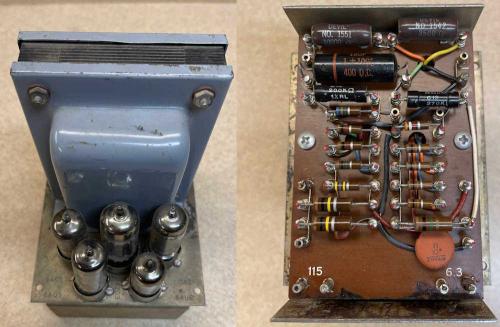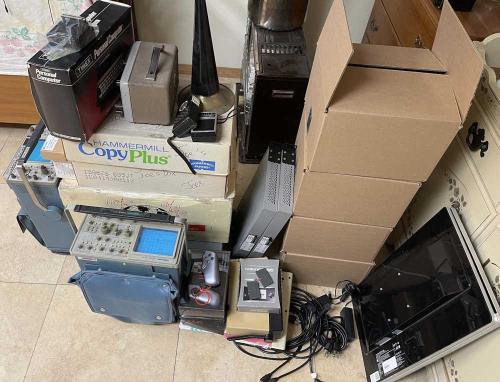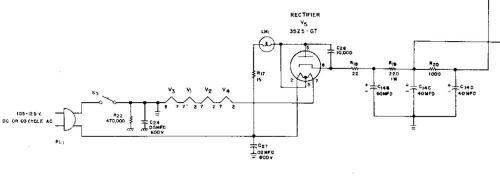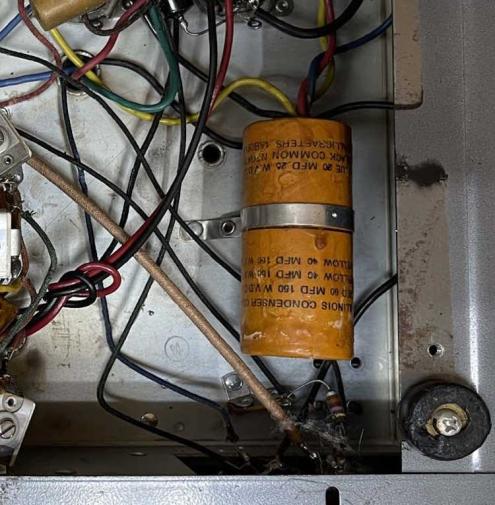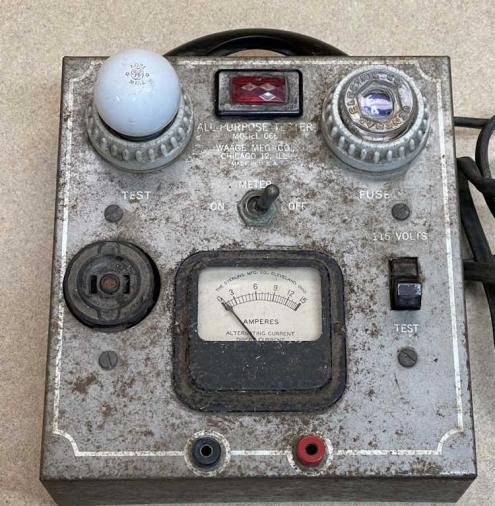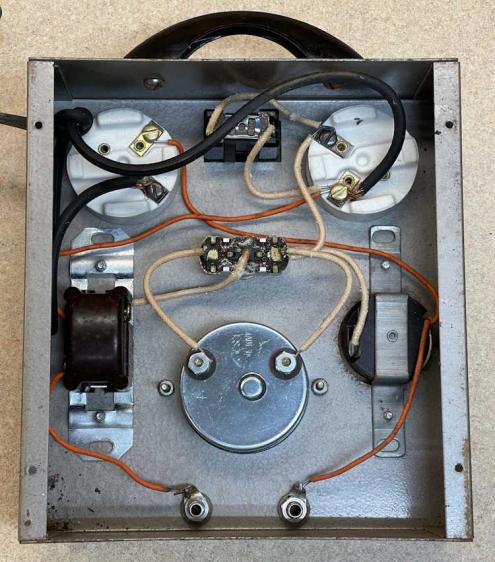- 2024
- Aug
- 31
Pictures from the 2024 Johnstown Swappers Day
Saturday threatened rain all morning, and that seemed to keep the crowds down this year - the roads were relatively clear on the way home. In contrast, last year was backed up for miles in every direction with people trying to get in.
We arrived fairly early, and some of the vendors hadn’t opened yet, but we wandered the aisles, had some Bourbon Chicken and Fried stuff, and managed to see it all. Most was just flea market stuff, but there was some cool things on site.
This Admiral console radio was in pretty good shape for it’s age.
For your 1812 Overture re-enactments.
An adorable miniature bulldozer. It’s low, maybe this was for use in a mine? (No, these were sold to the general consumer as a small piece of equipment. There were other attachments for it as well.)
A nice looking Edison Home unit with crane and witch hat horn. Did not pull the top off to look at it.
A clear Aladdin Beehive, and a pink and clear Aladdin Corinthian lamp. They were priced appropriately.
A Ford Model T. Price: 29k
A Sears Silvertone Trans-Oceanic clone. It was in ok shape, didn’t see the inside.
A nice Silvertone console radio. The eye tube was inside, but was laying on the chassis.
Standard of Ohio vanished in 1984 when purchased by BP.
A couple of old phones. The spotlight in the box beside them went home with me.
A real spinning wheel.
I suspect this was from a mine, but it was amusing regardless. (It’s from an oilfield, from what I’ve seen.)
It looked like it was going to rain about 11AM, so we finished up and headed home.
- 2024
- Aug
- 22
The NRI (Conar 200) “Appliance Tester”
I’m not sure what fascinates me about these little test boxes - maybe it’s the attempt by the manufacturer to put as many functions into a small a space as they can. Regardless, this little test box is one of those devices. Yes, it’s a device that could be replaced by a simple digital multimeter and a couple of cables, but this was supposed to be an all-in-one device with all of the necessary connections to do the job at hand.
This device is a tester from NRI, or National Radio Institute - a former school by mail organization. This device was probably included, unassembled, as part of one of the courses. It’s state gave you a chance to learn assembly and soldering, as well as some circuit basics. It was later marketed on it’s own as the Conar 200, Conar being the consumer imprint of NRI where you could purchase NRI devices without the need for the coursework.
This device came from the 2024 Cuyahoga Falls Hamfest, and was $3. I didn’t really buy it for the test box itself, but more the real copper clips and probes that were in the storage compartment. The device itself was interesting enough (but smells horribly of basement!) that I decided to check it out a little.
At first glance, it appears to be a multimeter - and it is. It features a battery powered two-scale ohmmeter, a two-scale voltmeter, and a single scale ammeter. The volts and amps functions are simple metered measurements without any kind of filtering or scaling save that necessary to make it a high or low range. It has pin jacks for probing the device under test, and a socket so you can do direct amp measurements. That’s all.
It’s a very simple, unisolated device. The cordset is live when the probes are, and vice-versa.
The back of the device is fairly simple as well. A few resistors, a potentiometer, the meter connections, fuse, and some sockets are all you’ll find, along with the battery for the ohms function (removed in this image.) The wire is of fairly small gauge for 20A, so this isn’t something you’d want to run for a long period of time. It’s really about as simple as you can get, and is a pretty good meter for just having around and not worrying about batteries (for the most part.)
The battery in the device is a little odd, the kit required that you solder it in. There’s no battery holder save the spring clip. You’re absolutely right in thinking that you’re not supposed to solder on batteries, and that’s for multiple reasons. The two biggest reasons is the electrodes aren’t really meant to handle heat like that, and in newer batteries the electrolyte is wet(ter.) Heat could potentially cause it to burst or burn.
The battery in this one had leaked over the years, but fortunately for me it was a carbon cell. The electrolyte caused oxidation on the battery surface, but there’s no alkaline corrosion mess all over the place.
I’ll probably stick a battery in it at some point and see if it works. I can’t believe it doesn’t, there’s nothing there to not work!
- 2024
- Aug
- 14
Has it really been 30 years?
It’s been a while, hasn’t it, old friend? I didn’t think you worked anymore, but it looks like you’re still sitting there patiently waiting for input. Your power connector is loose, so we need to see about that, but I’ll see if I can find your manual and make some magic.
- 2024
- Aug
- 12
The PACO B-10 Battery Eliminator and Charger
I picked this guy up at the Columbus Hamfest for $5. It claims to be a power supply of sorts, and a battery charger. It is lopsidedly heavy. So at minimum, there’s a nice big transformer in the thing, if all else fails.
It’s fairly unassuming from the outside. The front has the business end of the device - two meters, output terminals, output adjust, and a couple of switches.
As a note, this thing is only 6 and 12 volt, with a little wiggle room.
The back and sides are just as unassuming, nothing except some vents, the cord, and a serial number.
You’d think there’s some sort of regulation in this device, right? Wrong.
There’s pretty much nothing inside of this guy. Apparently, the only regulation is YOU, and that’s by turning the dial on the front of the device!
Inside, it’s a history lesson in electronics.
Lots of cloth-coated solid wire and big wads of copper and metal make up this device.
Here’s the power transformer, two giant sized but comparatively small value capacitors, and a giant choke in the middle that hides the voltage adjust tap.
Here’s some boom cans, aka old capacitors. These claim to have been made by Pyramid in 1958. 6000uF at 20V - these can be replaced by 6800@25 for about $4 each, and two of them would fit handily in the space taken by one, with room to spare!
No, I’m not going to try and charge them!
Last, we have the business end of the device. The rectifiers - in this case, giant selenium plates. I wonder what kind of condition these things are in. Are rotten eggs in my future?
This is certainly a product of it’s time - it’s interesting in that it’s a battery charger not made by one of the companies that did such things at the time, but also tries to be a primitive DC supply for device bench testing. Now, of course, we’d just grab a 20A switcher, but this thing was what you had in the 50s.
Is it going to go back in service? Not until I can at least get some new capacitors, but even then - it may just end up as nice power supply transformer in a box. Who knows where this is going…
These pictures were accepted by Radiomuseum for one of their exhibits. Check them out! https://www.radiomus … minator_kit_b.html#a
- 2024
- Aug
- 11
These giant selenium rectifier plates
I recently picked up an ancient PACO B-10 “Power Supply / Battery Charger” from the Columbus Hamfest. I wasn’t sure what was in the thing, but turns out there’s not much.
These giant selenium plates, however, are a thing of ancient beauty. The whole thing looks like it’s era, a mash of wire, transformers, and rust. Stay tuned for a more complete teardown and other photos of this device.
- 2024
- Aug
- 7
Pretty good for just pulling it out of a junk bin.
Here’s the decade box I pulled out of a box of parts and junk at the recent Columbus Hamfest.
Granted, my old Keithley Meter hasn’t been calibrated in many years, but … 2 Ohms? I’ll take it!
- 2024
- Aug
- 7
My haul from the 2024 Columbus Hamfest
I brought home some things that I didn’t need, but isn’t that the point of this kind of show?
A Vishay decade box and a frequency counter / generator. They both seem to work well enough for the age. There’s also some high-voltage mica capacitors sitting on top of the decade box. Those were a buck, and I said why not?
I can’t go to a show without bringing home at least one meter. Unfortunately, this one seems to have some issues, it will zero but not read. I need to open it up and make sure that any batteries left in it aren’t corrodeedoodled all over the place. It had a lot of bad resistors in the divider chain.
This PACO generator is the same as one I have in better condition. This one is a $5 parts unit.
This is a PACO power supply that came from the same vendor as the generator, also $5. It’s an interesting piece, being an early bench supply for audio work, but in reality it’s a glorified battery charger. Stay tuned for a teardown on this guy. It eventually got passed on to someone for scrap. That’s what it’s worth!
No idea what this is, my fellow show-goer suggested it was some sort of early electronic switch for process industry. He’s probably right, but I got it simply for the cheapness of a 250VAC transformer that could be reused. I tore it down for parts.
That’s it for this year. I’ll be posting show pictures, and some other, recent engine shows as soon as I can get the images cleaned up.
- 2024
- Aug
- 4
It’s time to clean out some stuff - maybe to Dayton 2025?
One of my fellow show-goers was talking about taking some of the audio gear he collected to Dayton in 2025, and we’ll set up a table on the flea market. This sounds like a cool idea to me, I’ve attended shows but never had a sales table.
In the spirit of things, I took a look at what I’ve collected over the years that’s never going to go anywhere, and there’s a bunch. It’s time to start cleaning out, and I have a bunch of things that could go. Where does it all come from?
See you there, and maybe you can take something home! It’s cheap cheap cheap!
(If you see something you like, drop me a line on LinkedIn and we’ll see about a deal!)
Yep, it’s all gone!
- 2024
- Jul
- 31
Replacing the filter capacitors in a Hallicrafters S-38C
One of the things I picked up at Dayton this year was a really nice example of an S-38C multi-band radio. Completely untouched inside, it of course has bad filters. That’s par for the course for one of these. (It probably also has some silver mica disease, but that’s another day’s problem!)
Replacing them is easy enough, but it all depends on how you want to do it. Some prefer to keep it original, opening up the can on the multi-section device and putting new components inside. Others just wrap capacitors wherever there’s a place to put them. I’m thinking of going a different direction with this one.
Most of Hallicrafters low-end transformerless sets used similar multi-section capacitors and dropping resistors.
(Schematic from the Riders Manual.)
Some, like this one, used a 220Ω and 1kΩ resistor, others (like the S-95) used a 470Ω instead of the 1K.
So…why not create some sort of universal PCB that can drop in and replace all of the filter capacitors, sans the cathode bypass capacitor used in the audio stage of some of the units?
I had thought of using axial devices, but those can get expensive. What’s not expensive, and are compact and readily available? Surface mount parts. A small board could be created with three capacitors and space for the two dropping resistors, pre-assembled (or partially, depending on what you’re trying to fix,) and either double-side taped in or bolted down. The board wouldn’t need to have any through holes, wires could simply lay on pads and be soldered down. 5W resistors and 160V capacitors exceed original specifications, and would be easy to install on the board.
There’s certainly plenty of room in the device once the original can has been removed.
Wow, those feet are in bad shape…need to find some replacements!
I know that idea will offend some purists, but that’s not my concern here. I want to get the device back up and running with good quality parts that fit in the space required, without drilling a lot of holes or simply shooting parts all over the place.
I just need to brush up on my PCB skills, and lay out the board for sizing. Stay tuned!
- 2024
- Jul
- 4
Yet another test box - The Waage Model 066.
This is a benchtop test box I picked up at the Breezeshooter’s Hamfest this past June. It’s simply a switched, fused outlet with some indicator lamps and a current meter. It proclaims itself to be a Waage Electric Model 066, “All Purpose Tester.” It’s in eh shape, and probably sat on someone’s bench for decades.
The cord is in good shape, which is surprising for the age, but both the neon pilot lamp and the little 7W peanut bulb for the circuit test are dead. It was probably “on” for most of it’s life. The neon bulb in the pilot doesn’t even do the flickering thing at this point.
Everything seems to be mechanically working, the switch snaps with a nice thunk, the meter pointer moves but needs to be adjusted, and all of the sockets are intact. Of note here is the Edison Fuse - no 3AG glass fuses here!
The inside is pretty clean, overall. I can immediately see the cord appears to have been replaced because of the way it’s put on the screw terminals - it’s unlikely the factory would have shipped it all birdcaged out like that. So that’s probably a new(er) cord.
Of real not here is the small gauge wire used for the device. The orange wire appears to be about 22GA solid - that’s not going to handle the 15A this thing is supposedly rated for. It makes me wonder if this thing was completely redone at some point in time, as there’s a mix of thermoplastic and cloth-coated wire in this. It’s of an age where everything would have been cloth coated.
In all, it’s kind of a neat piece, and was probably meant for testing products of the kind that Waage made - heating devices such as irons and coffee pots. For the $1 I paid for it, it’s literally a nothing lost proposition.
If I wanted to use it, the non-polarized outlet would need to be replaced, as would the cord and small gauge wire. I’d probably try and save the original pilot lamp, and find an incandescent bulb for the test socket.
But who knows. It’s of limited use other than a “That’s cool” thing to have on your bench. I’ll probably clean it up and see what I can do with it, stay tuned!
